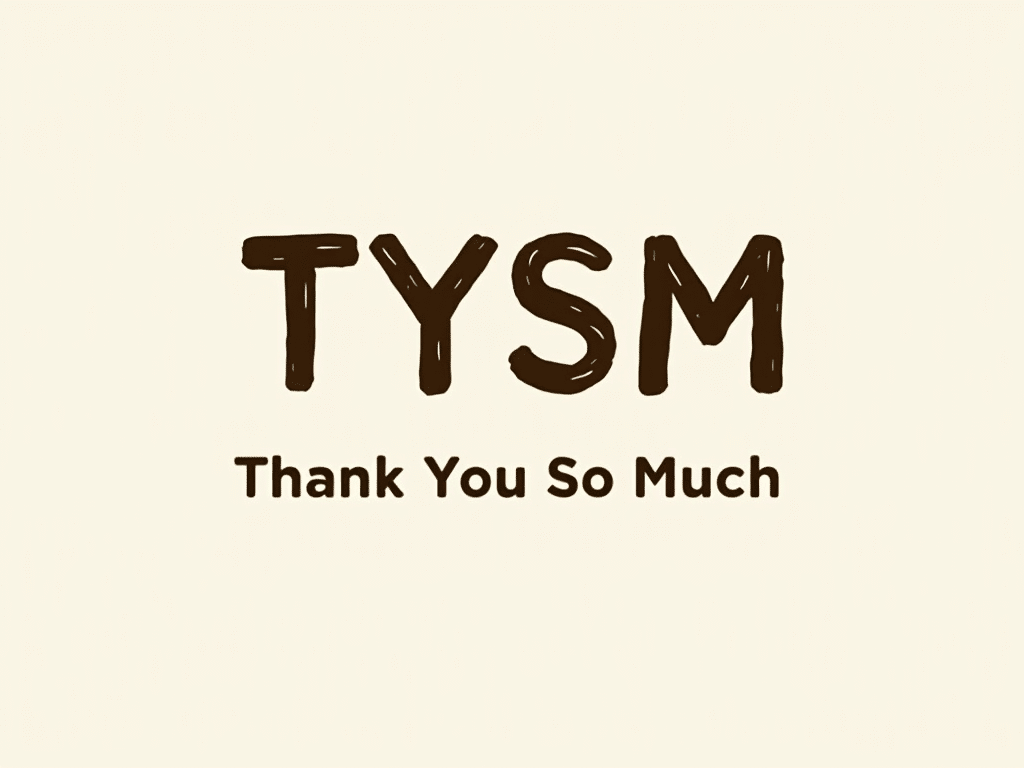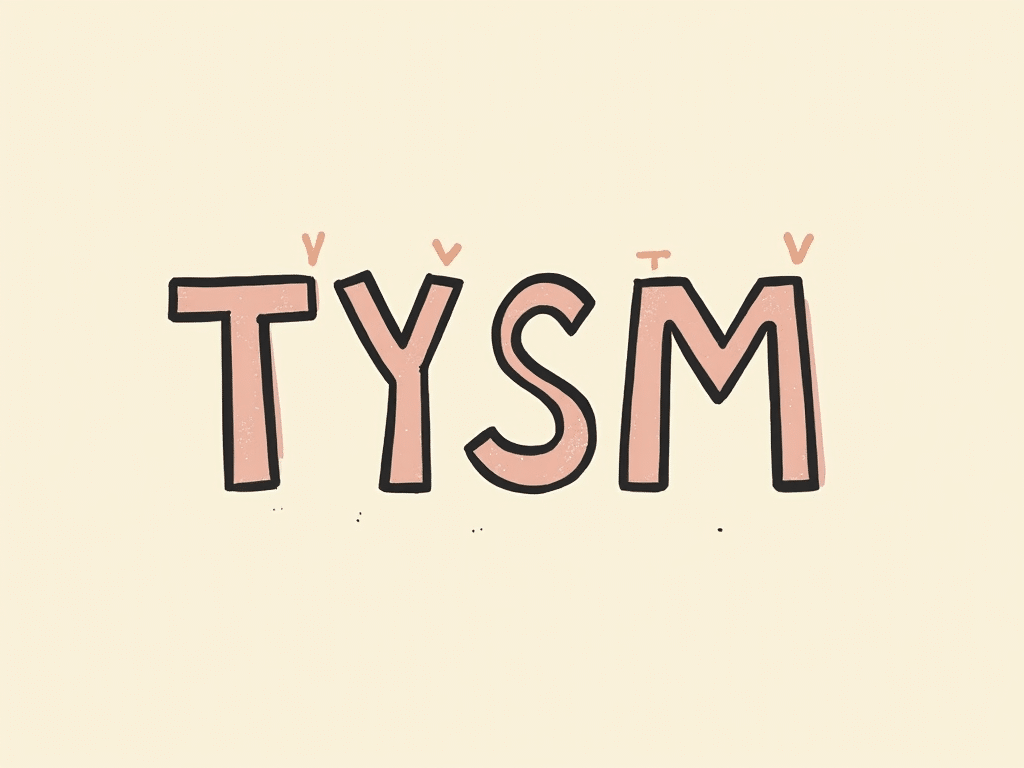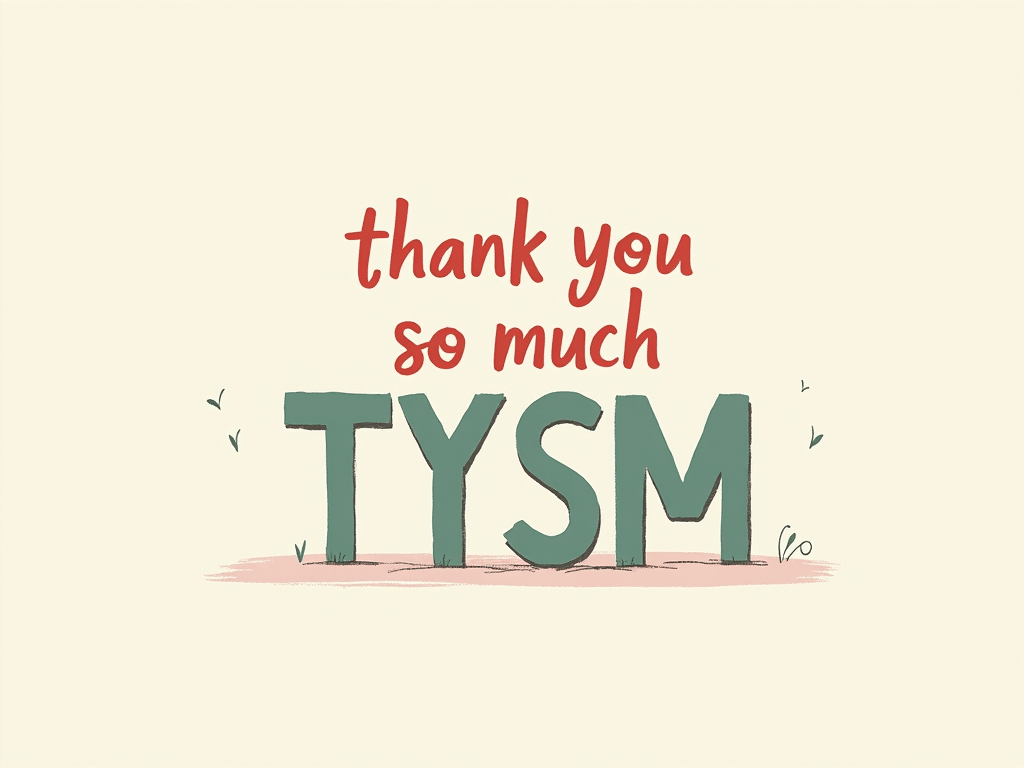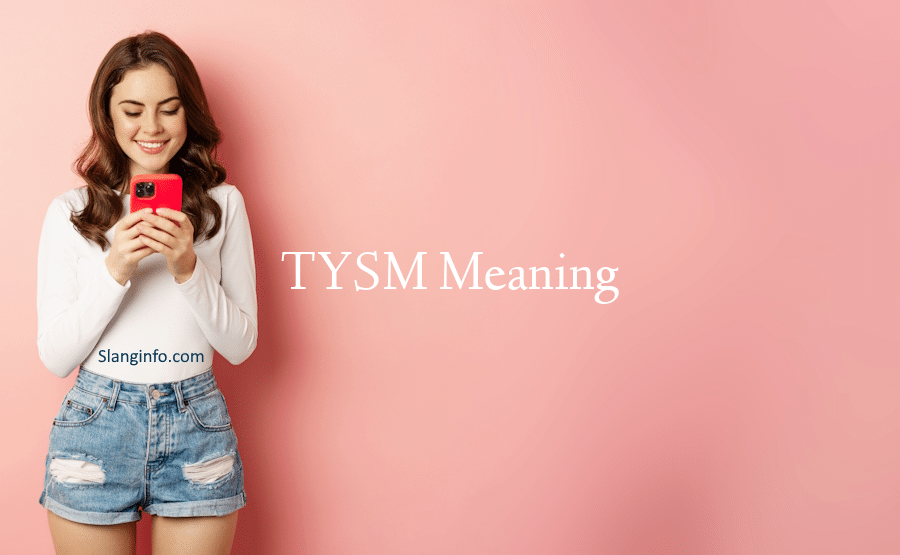In the fast-paced world of digital communication, slang and acronyms have become an essential part of our online vocabulary. One such acronym that has gained widespread popularity is “TYSM.” But what does TYSM mean, and why has it become so ubiquitous in our digital conversations? Let’s dive into the world of this friendly expression and uncover its origins, usage, and significance in modern communication.
What Does TYSM Stand For?

TYSM is an acronym that stands for “Thank You So Much.” This expression is used to convey gratitude in a more emphatic way than a simple “thank you” or “thanks.” By adding “so much” to the phrase, users can express a higher level of appreciation or enthusiasm in their thanks.
Origins of TYSM
The acronym TYSM emerged as a natural evolution of internet shorthand. As online communication platforms began to limit character counts (like Twitter’s original 140-character limit) and mobile texting became more prevalent, users sought ways to express common phrases more efficiently. “Thank you so much” is a frequently used expression, making it a prime candidate for abbreviation.
TYSM Meaning in Text

In text messages and instant messaging, TYSM has become a go-to expression for showing appreciation. Its usage in text conversations offers several advantages:
- Efficiency: It’s quicker to type four letters than the full phrase.
- Emphasis: It can feel more sincere or enthusiastic than a simple “TY” (thank you).
- Tone: In text-based communication where tone can be hard to convey, TYSM helps express warmth and gratitude more clearly.
Examples of TYSM in text conversations:
- “Thanks for helping me with my homework! TYSM!”
- “I got the package you sent. TYSM, you’re the best!”
- “TYSM for remembering my birthday!”
TYSM on Social Media Platforms

The use of TYSM has spread across various social media platforms, each with its own nuances:
Twitter Usage
On Twitter, where character count is still a consideration, TYSM is particularly popular. Users often include it in tweets to express gratitude to followers, acknowledge retweets, or thank others for sharing information.
Example tweet: “We’ve reached 10K followers! TYSM to everyone for your support! 🎉”
Instagram and Facebook
On platforms like Instagram and Facebook, TYSM is frequently used in comments to show appreciation for posts, in direct messages to thank for follows or likes, and in captions to express gratitude to an audience.
Example Instagram comment: “Your travel photos are amazing! TYSM for sharing your adventures! 😍”
TikTok Trends
On TikTok, TYSM has become part of the platform’s unique language. Creators often use it in video captions or in the comments section to thank viewers for their support.
Example TikTok caption: “100K followers?! TYSM y’all, couldn’t do it without you! 🥰 #Grateful”
For more on TikTok slang, check out our article on FYP meaning.
TYSM Meaning from a Girl

When a girl uses TYSM in communication, it generally carries the same meaning as when anyone else uses it – “Thank You So Much.” However, in certain contexts, particularly in flirting or romantic situations, it might be interpreted with additional nuance:
- Enthusiasm: A girl using TYSM might be showing extra enthusiasm or appreciation.
- Friendliness: It could be seen as a warm, friendly response, especially if accompanied by emojis.
- Politeness: In some cultures, women may be socialized to express more gratitude, making TYSM a common phrase.
Example: “TYSM for the lovely dinner! 😊”
It’s important to note that interpreting TYSM differently based on gender can lead to misunderstandings. The meaning is generally consistent regardless of who’s using it.
TYSM Meaning in Slang
While TYSM itself is a form of internet slang, it has become so commonplace that it’s now part of everyday digital language. Here’s how it fits into broader slang culture:
- Intensifier: TYSM is often used to intensify gratitude compared to a simple “thanks.”
- Tone setter: It can set a friendly, informal tone in conversations.
- Age indicator: Using TYSM might signal familiarity with internet culture, often associated with younger generations.
Comparison with other gratitude-expressing slang:
- “Thanks a mil” (million)
- “Cheers” (British/Australian slang)
- “You’re a lifesaver”
TYSM has remained popular due to its versatility and ease of use across various platforms. For more on internet slang, check out our articles on LIT meaning and BASED meaning.
TYSM in Professional Communication
The use of TYSM in professional settings is a topic of debate. Here are some considerations:
- Formality: TYSM is generally considered informal and may not be appropriate in highly formal business communications.
- Industry: Creative or tech-oriented industries might be more accepting of such acronyms.
- Relationship: The closeness of your professional relationship may influence the appropriateness of using TYSM.
Alternatives for more formal situations:
- “Thank you very much for your assistance.”
- “I greatly appreciate your help.”
- “Many thanks for your support.”
Generational differences play a role too. Younger professionals might use and accept TYSM more readily than older generations.
TYSM in Different Languages
While TYSM is primarily used in English-language communication, its influence has spread globally:
- Adoption: Non-native English speakers often use TYSM in English conversations.
- Translation: Some languages have created their own versions, like “MKTK” (Merci Ktir Ktir) in Lebanese Arabic.
- Code-switching: Bilingual speakers might use TYSM even when primarily communicating in another language.
Example: “Gracias por tu ayuda! TYSM!” (Spanish and English mix)
Conclusion: The Impact of TYSM on Digital Communication
TYSM has become an integral part of our digital lexicon, offering a quick and emphatic way to express gratitude. Its popularity stems from its efficiency, emotional expressiveness, and adaptability across various platforms and contexts. While primarily used in casual settings, TYSM is gradually finding its way into more diverse areas of communication.
Understanding the nuances of TYSM usage can help you navigate digital interactions more effectively, whether you’re chatting with friends, engaging on social media, or even in some professional contexts. As with all language trends, the key is to use TYSM thoughtfully and appropriately for your audience and situation.
For more insights into popular online slang and acronyms, check out our articles on FR meaning and GN meaning.
FAQs About TYSM
Q: Is it okay to use TYSM in a job application or formal email?
A: It’s generally best to avoid TYSM in very formal communications. Opt for “Thank you very much” instead.
Q: How do you pronounce TYSM if read aloud?
A: Most people would say the full phrase “Thank You So Much” rather than pronouncing the individual letters.
Q: Can TYSM be seen as insincere if used too often?
A: Yes, overuse of any expression can make it seem less genuine. Use TYSM when you truly feel heightened gratitude.
Q: Is TYSM used in languages other than English?
A: While TYSM is an English acronym, it’s sometimes used by non-native English speakers in digital communication. Some languages have created their own equivalent acronyms.
Q: How should I respond to someone who says TYSM to me?
A: A simple “You’re welcome!” or “Happy to help!” is usually sufficient. If you want to match their enthusiasm, you could say something like “Anytime! Glad I could help!”
Remember, language is constantly evolving, especially in digital spaces. Staying informed about acronyms like TYSM can help you communicate more effectively and understand the nuances of online interactions.







